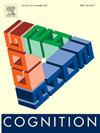观察到到达速度信号刺激值并通知觅食
IF 2.8
1区 心理学
Q1 PSYCHOLOGY, EXPERIMENTAL
引用次数: 0
摘要
最佳觅食要求代理在与环境刺激相互作用的潜在成本和回报之间取得平衡。对人类和动物觅食的研究表明,智能体分配给刺激的值与它们接近该刺激的速度相关(Shadmehr等人,2019)。人类和其他动物通过观察他人的行为来了解环境中刺激的价值(Pyke, 1984;博伊德,理查森&;亨利克先生,2011)。考虑到人类能够从特定的运动参数中获得特定的心理状态,如意图、情绪或信心(Becchio et al., 2012),我们的目的是研究观察者是否可以使用演员的运动速度来推断觅食刺激的价值;2)利用这些线索来指导它们自己的觅食行为。本研究首先复制了刺激值对新觅食任务中到达动作的影响(实验1,N = 34)。在三个进一步的实验中,我们证明,根据参与者到达刺激的速度,观察者推断这些刺激的值(实验2,N = 54),表达觅食偏好(实验3,N = 54),并投入时间和精力去觅食(实验4,N = 105)。这表明观察者通过从参与者接近刺激的方式推断刺激的价值来优化他们自己的探索-利用决策,突出了行动理解在成功觅食中所起的基本作用。本文章由计算机程序翻译,如有差异,请以英文原文为准。
Observed reaching speed signals stimulus value and informs foraging
Optimal foraging requires agents to strike a balance between potential costs and rewards of interacting with stimuli in the environment. Research on human and animal foraging shows that the value an agent assigns to a stimulus is correlated with the speed of their reaching movement towards that stimulus (Shadmehr et al., 2019). Humans and other animals learn about the value of stimuli in their environment by observing others acting (Pyke, 1984; Boyd, Richerson & Henrich, 2011). Considering that humans are able to derive specific mental states such as intentions, emotions or confidence from specific movement parameters (Becchio et al., 2012), we aimed to investigate whether observers can use an actor's movement speed to: 1) infer the value of a foraging stimulus; and 2) use such cues to inform their own foraging behavior. The current study first replicated the effect of stimulus value on reaching movements in a novel foraging task (Exp. 1, N = 34). In three further experiments, we demonstrate that, depending on the speed by which an actor reaches for stimuli, observers infer the value of these stimuli (Exp. 2, N = 54), express foraging preferences (Exp. 3, N = 54), and invest time and effort to forage (Exp. 4, N = 105). This demonstrates that observers optimize their own explore-exploit decisions by inferring the value of a stimulus from the manner by which an actor approaches it, highlighting the fundamental role that action understanding plays in successful foraging.
求助全文
通过发布文献求助,成功后即可免费获取论文全文。
去求助
来源期刊

Cognition
PSYCHOLOGY, EXPERIMENTAL-
CiteScore
6.40
自引率
5.90%
发文量
283
期刊介绍:
Cognition is an international journal that publishes theoretical and experimental papers on the study of the mind. It covers a wide variety of subjects concerning all the different aspects of cognition, ranging from biological and experimental studies to formal analysis. Contributions from the fields of psychology, neuroscience, linguistics, computer science, mathematics, ethology and philosophy are welcome in this journal provided that they have some bearing on the functioning of the mind. In addition, the journal serves as a forum for discussion of social and political aspects of cognitive science.
 求助内容:
求助内容: 应助结果提醒方式:
应助结果提醒方式:


